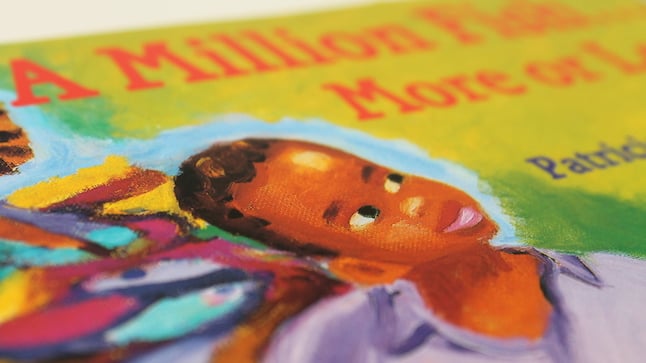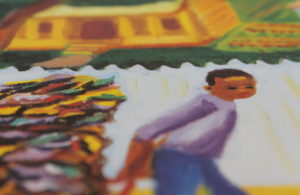Series: Book Ideas
Explore Estimation While Enjoying a Whopper of a Tale!

Ever exaggerate a good story? The little boy Hugh Thomas sure does in the book A Million Fish… More or Less by Patricia C. McKissack, illustrations by Dena Schutzer. In the book Hugh Thomas goes fishing in a swampy bayou. After listening to the tall tales of his elders, he catches on to the art of embellishing a story. He recounts catching a million fish in a half-hour and defending his catch against “one hundred alligators one hundred feet long [who] can move at one hundred yards per second.” Then he tells of battling a pirate raccoon who is after his fish in a contest of skipping rope. Hugh Thomas beats the raccoon by jumping 5,553 times before missing. Eventually he makes his way home with only three fish left, but a good story to tell!
 This book is a delightful way to start a discussion about estimation in the early grades. Is it reasonable that Hugh Thomas caught a million fish in 30 minutes? What about 100 fish? What about 10 fish? Building children’s estimation skills supports their number sense and helps them judge whether a number is reasonable or not.
This book is a delightful way to start a discussion about estimation in the early grades. Is it reasonable that Hugh Thomas caught a million fish in 30 minutes? What about 100 fish? What about 10 fish? Building children’s estimation skills supports their number sense and helps them judge whether a number is reasonable or not.
Estimation is the process of evaluating a quantity when the situation calls for a rough or tentative number. An estimate is not merely a “guess.” A reasonable estimate depends upon mathematical understandings of both numerosity and measurement.
For example, many teachers use an “estimation jar” to provide practice with estimation. In this activity, the teacher puts a collection of objects, such as marbles, in a clear plastic jar with a lid. The children estimate how many marbles are in it, recording their estimates and their names on sticky notes to post by the jar. At the end of the week, the class counts the collection and compares the count to the estimates.
When children look at a collection of marbles in a jar, they have to “picture” a number they can visualize such as 5 or 10 (numerosity). Then, they have to estimate how many of those units (5s or 10s) might fit in the jar (measurement). Finally, children count by 5s or 10s that many times (counting). Thus children need to learn the foundational skills of subitizing and counting well and build mental images of “benchmark” collections (10 looks like this; 50 looks like that) to estimate accurately.
An estimate is not merely a “guess.” A reasonable estimate depends upon mathematical understandings of both numerosity and measurement.
One suggestion is to add a “reference jar” next to your estimation jar. The two jars should be the same size and shape. Clearly label a benchmark collection, such as “50 marbles,” in the reference jar to support children’s estimation. Another suggestion is to allow children to revise their estimates based on a partial counting of the collection. For example, count roughly half of the marbles. Invite children to revise their estimates based on this new information. With experience, children can make increasingly accurate estimates… and that’s no exaggeration!